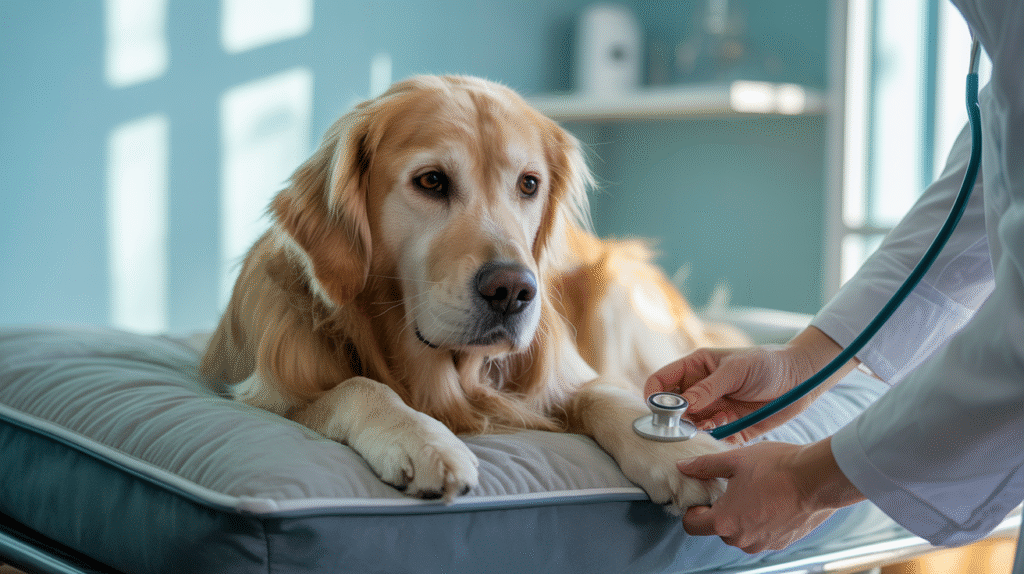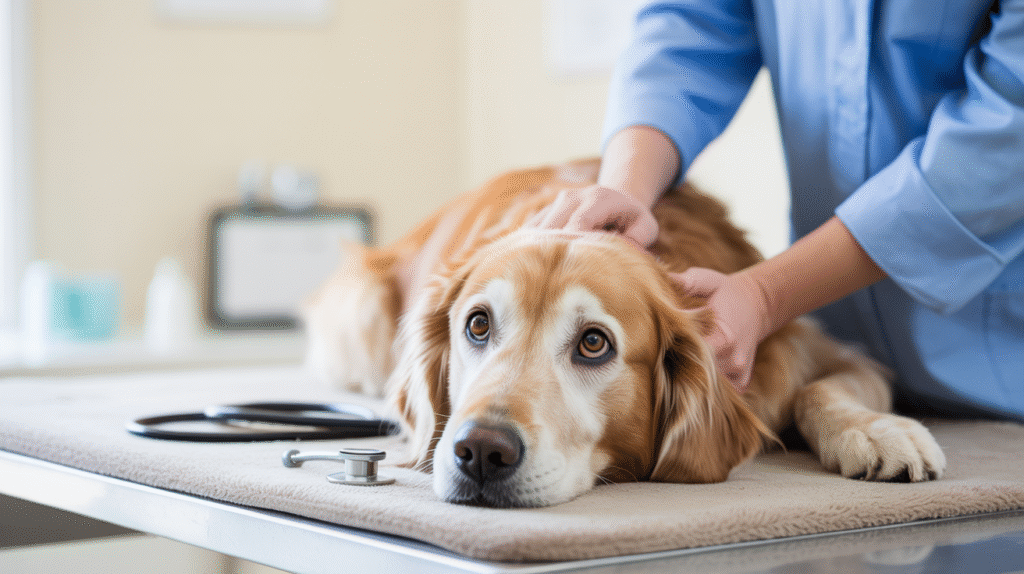10 Signs Your Dog Needs a Vet Visit Immediately
Every dog parent knows that heart-stopping moment when something seems “off” with their beloved furry friend.
Maybe they’re not eating with their usual enthusiasm, or they’re moving more slowly than normal.
But how do you know when to rush to the emergency vet versus simply keeping a watchful eye?
The difference between recognizing urgent dog health symptoms and dismissing them as minor issues can literally save your dog’s life.
As pet parents, we’re responsible for being our dogs’ voices when they can’t tell us they’re in pain or feeling unwell.
Dogs are masters at hiding discomfort—an evolutionary trait from their wild ancestors who couldn’t show weakness.
This makes it even more critical that we learn to recognize the warning signs that require immediate veterinary attention.
In this comprehensive guide, we’ll walk through 10 critical warning signs that your dog needs to see a veterinarian right away.
Whether you’re a first-time dog owner or a seasoned pet parent, understanding these emergency signs for dogs will help you make informed, potentially life-saving decisions when your furry companion needs you most.
Quick Overview: 10 Critical Warning Signs

Before we dive deep into each sign, here’s a quick reference list of the symptoms that should prompt an immediate vet visit:
- Persistent vomiting or diarrhea
- Difficulty breathing or excessive panting
- Sudden collapse or inability to stand
- Severe abdominal swelling or bloating
- Refusal to eat or drink for 24+ hours
- Bleeding that won’t stop
- Signs of extreme pain or distress
- Seizures or neurological symptoms
- Ingestion of toxic substances
- Pale gums or abnormal gum color
Now, let’s explore each of these dog emergency signs in detail so you’ll know exactly what to look for and when to act.
1. Persistent Vomiting or Diarrhea

While an occasional upset stomach is normal for dogs, persistent vomiting or diarrhea is one of the most common vet visit symptoms that shouldn’t be ignored.
Why It’s Concerning: Repeated vomiting or diarrhea can quickly lead to dangerous dehydration, especially in puppies, senior dogs, or smaller breeds. Additionally, these symptoms can indicate serious conditions like gastrointestinal obstruction, pancreatitis, kidney disease, or poisoning.
When to Act Urgently:
- Vomiting more than 3-4 times in a few hours
- Vomit contains blood (red or coffee-ground appearance)
- Diarrhea is bloody, black, or tar-like
- Your dog appears lethargic or weak
- Signs of dehydration (dry gums, sunken eyes, loss of skin elasticity)
- Accompanied by other symptoms like fever or abdominal pain
- Puppies or senior dogs showing these symptoms
When to Monitor: A single episode of vomiting or soft stool, especially if your dog recently changed food or ate something unusual, may not require emergency care. Monitor closely for 12-24 hours and ensure they stay hydrated.
Visual Cues to Watch: Check your dog’s gums—they should be pink and moist. Press on the gum gently; the color should return within 2 seconds. Delayed return indicates dehydration. Also, gently pinch the skin on your dog’s back—it should snap back quickly if they’re well-hydrated.
2. Difficulty Breathing or Excessive Panting

Respiratory distress is always an emergency requiring immediate veterinary attention and represents one of the most critical dog emergency signs.
Why It’s Concerning: Breathing difficulties can indicate life-threatening conditions including heart failure, pneumonia, allergic reactions, airway obstruction, or trauma to the chest. Dogs can’t breathe through their mouths as effectively as humans, so any breathing difficulty is serious.
When to Act Urgently:
- Labored breathing with extended neck and open mouth
- Blue or purple gums or tongue
- Rapid, shallow breathing when not hot or after exercise
- Wheezing, choking, or gasping sounds
- Refusing to lie down (sitting or standing to breathe easier)
- Excessive panting when at rest or in cool conditions
- Visible chest effort with each breath
What Normal Looks Like: Dogs normally breathe 10-30 times per minute at rest. Panting after exercise or in hot weather is normal, but it should resolve with rest and cooling.
Visual Cues: Watch your dog’s chest and abdomen. Normal breathing should be smooth and effortless. Labored breathing often involves pronounced chest movement, flared nostrils, or the abdomen working hard with each breath. Check gum color—healthy gums are pink, not pale, blue, or bright red.
3. Sudden Collapse or Inability to Stand

If your dog suddenly collapses, loses consciousness, or can’t stand up, this is one of the clearest dog health emergencies requiring immediate action.
Why It’s Concerning: Collapse can indicate severe conditions including heart problems, internal bleeding, poisoning, severe pain, neurological disorders, or heatstroke. Even if your dog recovers quickly, the underlying cause needs immediate investigation.
When to Act Urgently:
- Any sudden collapse, even if brief
- Inability to stand or walk normally
- Loss of consciousness
- Staggering or extreme weakness
- Collapse accompanied by pale gums, rapid breathing, or signs of pain
- Recent trauma or injury
Common Causes:
- Cardiovascular problems (heart disease, arrhythmias)
- Severe anemia or blood loss
- Hypoglycemia (low blood sugar), especially in small breeds
- Seizures or neurological events
- Extreme pain from injury or illness
- Heatstroke or dehydration
- Toxin ingestion
What to Do: Keep your dog calm and comfortable. Don’t force them to stand. Note the time, duration, and any other symptoms. If they’ve collapsed outside in heat, move them to a cool area and apply cool (not cold) water to their paws and belly while heading to the vet.
4. Severe Abdominal Swelling or Bloating

Gastric dilatation-volvulus (GDV), commonly known as bloat, is a life-threatening emergency that requires immediate veterinary intervention. This is especially critical among emergency signs for large breed dogs.
Why It’s Concerning: Bloat occurs when the stomach fills with gas and potentially twists on itself, cutting off blood supply. Without treatment within hours, it’s often fatal. Large, deep-chested breeds like Great Danes, German Shepherds, and Standard Poodles are at highest risk.
When to Act Urgently:
- Visible abdominal distension (swollen, tight belly)
- Unproductive retching (trying to vomit but nothing comes up)
- Excessive drooling
- Restlessness and inability to get comfortable
- Rapid breathing or panting
- Weakness or collapse
- Pale gums
Risk Factors:
- Large or giant breed dogs
- Deep, narrow chest conformation
- Eating one large meal daily
- Eating too quickly
- Exercise immediately before or after eating
- Family history of bloat
Prevention Tips: Feed smaller meals 2-3 times daily, use slow-feeder bowls, avoid exercise right after meals, and consider a preventive gastropexy surgery for high-risk breeds.
Time is Critical: Bloat can progress to shock and death within a few hours. If you suspect bloat, don’t wait—get to an emergency vet immediately.
5. Refusal to Eat or Drink for 24+ Hours

While dogs occasionally skip meals, complete loss of appetite or thirst for more than 24 hours is a significant vet visit symptom that warrants attention.
Why It’s Concerning: Loss of appetite (anorexia) can indicate pain, nausea, fever, organ dysfunction, dental problems, or serious illness. Refusal to drink is especially concerning as dehydration develops quickly.
When to Act Urgently:
- No food or water for 24+ hours in adult dogs (12 hours for puppies)
- Accompanied by lethargy, vomiting, or diarrhea
- Visible weight loss or weakness
- Dry, tacky gums
- Sunken eyes
- Loss of skin elasticity
- Known ingestion of toxins or foreign objects
When to Monitor: Dogs may refuse food due to stress, minor stomach upset, or being finicky. If your dog is otherwise acting normal, drinking water, and the environment has recently changed, you might monitor for another 12 hours.
Common Causes:
- Gastrointestinal upset or obstruction
- Dental disease or oral pain
- Kidney or liver disease
- Pancreatitis
- Infections
- Cancer
- Medication side effects
What to Try: Offer different foods, warm up the food slightly, try hand-feeding, or add low-sodium broth. However, don’t delay veterinary care trying home remedies if your dog seems unwell in other ways.
6. Bleeding That Won’t Stop

Uncontrolled bleeding from any part of the body requires immediate veterinary attention and represents a clear medical emergency for dogs.
Why It’s Concerning: Excessive bleeding can lead to shock, organ failure, and death. Additionally, the source of bleeding may indicate trauma, poisoning (especially rat poison), clotting disorders, or internal injuries.
When to Act Urgently:
- Any bleeding that doesn’t stop with 5-10 minutes of direct pressure
- Blood in vomit (red or coffee-ground appearance)
- Blood in urine (pink, red, or brown urine)
- Blood in stool (bright red or black, tarry stool)
- Bleeding from nose, mouth, ears, or eyes
- Visible wounds with significant blood loss
- Evidence of internal bleeding (pale gums, weakness, distended abdomen, bruising)
Emergency First Aid:
- Apply direct pressure with clean cloth or gauze for 5-10 minutes
- Don’t remove the cloth to check—this disrupts clot formation
- If blood soaks through, add more layers on top
- Keep your dog calm and still
- Get to the vet immediately while maintaining pressure
Types of Bleeding:
- External bleeding from wounds or lacerations
- Internal bleeding (harder to detect, watch for weakness, pale gums, rapid breathing)
- Bleeding from body openings (nose, mouth, rectum, urinary tract)
7. Signs of Extreme Pain or Distress

Dogs often hide pain, so when they show obvious signs of severe discomfort, it’s a critical situation requiring immediate care.
Why It’s Concerning: Extreme pain indicates serious injury or illness that needs prompt diagnosis and pain management. Untreated pain can lead to shock, decreased immune function, and slower healing.
When to Act Urgently:
- Crying, whimpering, or howling
- Aggression when touched (especially if normally friendly)
- Trembling or shaking
- Hunched posture or reluctance to move
- Rapid breathing or panting
- Dilated pupils
- Refusal to eat
- Hiding or seeking isolation
- Protective of specific body area
- Restlessness and inability to settle
Common Pain Indicators by Location:
- Abdominal pain: hunched back, guarding abdomen, “prayer position” (front down, rear up)
- Back/neck pain: reluctance to jump, climb stairs, or lift head
- Joint pain: limping, difficulty standing, stiffness
- Dental pain: pawing at mouth, drooling, dropping food
What Not to Do: Never give human pain medications (acetaminophen, ibuprofen, aspirin) to dogs—they can be toxic and potentially fatal. Only use medications prescribed by your veterinarian.
8. Seizures or Neurological Symptoms

Any seizure—especially a first-time seizure or seizures lasting more than 5 minutes—requires immediate veterinary evaluation.
Why It’s Concerning: Seizures can indicate epilepsy, poisoning, brain tumors, infections, metabolic disorders, or other serious neurological conditions. Prolonged seizures (status epilepticus) can cause permanent brain damage or death.
When to Act Urgently:
- First-time seizure
- Seizure lasting longer than 5 minutes
- Multiple seizures within 24 hours (cluster seizures)
- Difficulty breathing during or after seizure
- Your dog doesn’t regain consciousness between seizures
- Seizures accompanied by other neurological signs
What a Seizure Looks Like:
- Loss of consciousness
- Falling to the side
- Rigid limbs or paddling movements
- Drooling or foaming at the mouth
- Loss of bladder or bowel control
- Confusion or disorientation afterward
Other Neurological Warning Signs:
- Head tilt
- Loss of balance or coordination
- Circling or pacing
- Vision changes or blindness
- Weakness in limbs
- Unusual eye movements
- Behavior changes or confusion
During a Seizure: Keep your dog safe by moving furniture away, don’t put anything in their mouth, time the seizure, and stay calm. Speak softly but don’t restrain them. After the seizure, keep the environment quiet and dimly lit while you transport to the vet.
9. Ingestion of Toxic Substances

If you know or suspect your dog has ingested anything toxic, time is of the essence. This is one of the most preventable yet serious dog health emergencies.
Why It’s Concerning: Many common household items are toxic to dogs, and early intervention dramatically improves outcomes. Some toxins cause immediate symptoms, while others have delayed effects that are more dangerous once symptoms appear.
Common Toxins to Know:
- Foods: chocolate, grapes/raisins, xylitol (artificial sweetener), onions, garlic, macadamia nuts, alcohol
- Medications: human pain relievers, antidepressants, blood pressure medications, ADHD medications
- Household items: antifreeze, rodent poison, insecticides, cleaning products
- Plants: lilies, sago palm, azaleas, oleander, tulips
- Other: recreational drugs, marijuana products, essential oils, nicotine
When to Act Urgently:
- Immediately after ingestion, even before symptoms appear
- Witnessed or suspected toxin ingestion
- Symptoms of poisoning: vomiting, diarrhea, drooling, tremors, seizures, weakness, difficulty breathing
What to Do:
- Identify what was ingested and how much
- Call your vet or Pet Poison Helpline (855-764-7661) immediately
- Don’t induce vomiting unless specifically told to do so—some substances cause more damage coming back up
- Bring the product packaging with you to the vet
- Note the time of ingestion
Prevention: Keep all potentially toxic substances locked away, secure trash cans, be cautious with holiday decorations, and know which plants in your home and yard are toxic.
10. Pale Gums or Abnormal Gum Color

Your dog’s gum color is a window into their cardiovascular health and oxygenation. Abnormal gum color is a critical indicator of dog health emergencies.
Why It’s Concerning: Gum color changes indicate problems with circulation, oxygenation, or blood loss. This can signal shock, internal bleeding, heart problems, anemia, or respiratory failure.
Normal vs. Abnormal:
- Normal: Pink and moist (like bubble gum pink)
- Pale or white: shock, anemia, blood loss, poor circulation
- Blue or purple: lack of oxygen, respiratory or heart failure
- Bright red: overheating, carbon monoxide poisoning, shock
- Yellow: liver problems, jaundice
- Red spots or bruising: clotting disorders, poisoning
When to Act Urgently:
- Any gum color that isn’t healthy pink
- Pale gums accompanied by weakness, rapid breathing, or collapse
- Gums that don’t return to pink within 2 seconds after pressing (capillary refill time)
- Gums that are dry or tacky instead of moist
How to Check: Gently lift your dog’s lip and press on the gums with your finger. The area should blanch (turn white), then return to pink within 1-2 seconds. Practice this when your dog is healthy so you know what’s normal for them.
What It Indicates:
- Pale/white gums: emergency—internal bleeding, severe anemia, shock
- Blue/purple gums: critical emergency—oxygen deprivation
- Bright red gums: possible heatstroke or poisoning
- Yellow gums: liver disease or red blood cell destruction
When to Go to ER vs. Regular Vet
Understanding the difference between an emergency vet visit and an urgent care appointment can help you make the right decision for your dog.
Emergency Vet (Immediate, After-Hours):
- Any life-threatening condition listed above
- Difficulty breathing
- Uncontrolled bleeding
- Seizures
- Suspected poisoning
- Bloat symptoms
- Collapse or unconsciousness
- Severe trauma or injury
- Heatstroke
- Labor complications
Urgent Vet Care (Same-Day or Next-Day):
- Mild vomiting or diarrhea without other symptoms
- Minor limping without severe pain
- Small cuts or abrasions
- Eye irritation or discharge
- Ear infections
- Mild allergic reactions (no breathing difficulty)
- Skin issues or hot spots
Emergency Resources to Save:
- Your regular veterinarian’s phone number
- Nearest 24-hour emergency veterinary hospital
- Pet Poison Helpline: (855) 764-7661
- ASPCA Animal Poison Control: (888) 426-4435
When in Doubt: If you’re unsure whether your dog’s symptoms constitute an emergency, call your vet or an emergency clinic. They can help you assess the situation and provide guidance. It’s always better to err on the side of caution.
Preparing for the Vet Visit
Being prepared can make the veterinary visit more efficient and help your vet provide the best care for your dog.
Information to Gather:
- Detailed symptom timeline (when symptoms started, progression)
- Your dog’s normal behavior and any changes
- Recent diet changes or new foods
- All medications and supplements (bring containers)
- Recent activities or exposures
- Previous medical history and current conditions
- Vaccination records if seeing a new vet
Questions to Document:
- When did symptoms begin?
- Have symptoms gotten better, worse, or stayed the same?
- Has your dog eaten or drunk anything unusual?
- Any recent changes in environment, routine, or household?
- Is your dog on any medications?
- Any known allergies?
Safe Transport Tips:
- Keep your dog calm and comfortable
- Use a carrier for small dogs or secure larger dogs in the back seat
- Bring towels in case of accidents
- Have someone else drive if possible so you can monitor your dog
- Bring a recent photo in case you get separated
- Bring any vomit, stool, or urine samples if relevant
Questions to Ask Your Vet:
- What is causing these symptoms?
- What treatment options are available?
- What is the prognosis?
- What warning signs should I watch for?
- When should I schedule a follow-up?
- Are there any restrictions on activity or diet?
- What can I do at home to help my dog recover?
Preventive Tips to Avoid Emergencies
While not all emergencies can be prevented, these practices can help you catch problems early and reduce the risk of serious health issues.
Daily Dog Health Checklist:
- Monitor eating and drinking habits
- Check stools for consistency and color
- Observe energy levels and behavior
- Look for limping or difficulty moving
- Check eyes for clarity and discharge
- Examine ears for redness, odor, or discharge
- Feel for unusual lumps or bumps during petting
- Watch for scratching, licking, or skin irritation
Weekly Health Checks:
- Brush teeth or check for dental issues
- Inspect paws and nails
- Check gum color and moisture
- Weigh your dog to track changes
- Review coat condition and skin health
Early Symptom Recognition:
- Know your dog’s normal baseline behavior
- Document any changes, even subtle ones
- Take photos or videos of concerning symptoms
- Keep a health journal for chronic conditions
- Trust your instincts—you know your dog best
Routine Preventive Care:
- Annual veterinary exams (twice yearly for seniors)
- Stay current on vaccinations
- Year-round parasite prevention
- Regular dental care and cleanings
- Proper nutrition and weight management
- Regular exercise appropriate for age and breed
- Mental stimulation and enrichment
Home Safety:
- Pet-proof your home and yard
- Secure toxic substances and medications
- Use childproof locks on cabinets
- Keep trash cans secured
- Remove toxic plants
- Supervise around water
- Keep small objects that could be swallowed out of reach
Frequently Asked Questions
How often should my dog see the vet? Healthy adult dogs should have annual wellness exams. Puppies need more frequent visits for vaccinations and development checks (typically every 3-4 weeks until 16 weeks old). Senior dogs (7+ years for large breeds, 10+ for small breeds) benefit from twice-yearly checkups to catch age-related issues early.
What if it turns out to be a false alarm? Never feel embarrassed about bringing your dog to the vet for what turns out to be a minor issue. Veterinarians would rather see your dog for a false alarm than have you wait too long with a true emergency. Your vigilance and quick response could save your dog’s life, and vets appreciate owners who are attentive to their pets’ health.
How can I tell if my dog is in pain? Dogs often hide pain, but signs include changes in behavior, decreased activity, reluctance to move or jump, changes in appetite, excessive panting, whimpering, aggression when touched, restlessness, and changes in posture (hunching, guarding). Subtle signs like decreased interaction, sleeping more, or moving more slowly can also indicate pain.
What are signs of stress in dogs at the vet? Common stress signs include panting, drooling, trembling, tucked tail, pinned ears, whale eye (showing whites of eyes), trying to hide or escape, and excessive licking. You can help by staying calm yourself, bringing favorite treats, using a calming pheromone spray, and speaking in soothing tones.
How can I keep my dog calm during an emergency? Your dog takes cues from you, so staying calm is crucial. Speak in soothing, quiet tones. Minimize handling of painful areas. Keep the environment calm and quiet. If possible, have someone your dog trusts accompany them. Bring a favorite blanket or toy for comfort. Some dogs benefit from gentle pressure or being wrapped in a towel (like swaddling).
Should I give my dog anything before going to the vet? Generally, don’t give food, water, or medications before an emergency vet visit unless specifically instructed by the vet. If your dog needs surgery or sedation, an empty stomach is safer.
Don’t give human medications, which can be toxic. Call ahead to the vet and follow their specific instructions.
Conclusion
Being able to recognize these 10 critical warning signs can make the difference between life and death for your beloved companion.
As dog parents, we must be our pets’ advocates and voices when they can’t tell us something is wrong.
Remember, dogs instinctively hide weakness and pain, so by the time symptoms are obvious, the problem may already be serious.
Trust your instincts. You know your dog better than anyone, and if something feels off, it probably is.
When in doubt, always err on the side of caution and contact your veterinarian. A phone call to assess the situation is always better than waiting and regretting it later.
Keep emergency contact information readily available, including your regular vet, the nearest 24-hour emergency clinic, and poison control hotlines.
Take photos or videos of concerning symptoms to show your vet. Stay calm in emergencies—your dog needs you to be their steady presence during scary situations.
Prevention is powerful. Regular veterinary checkups, staying current on preventive care, and daily health monitoring can help you catch issues before they become emergencies.
Build a relationship with your veterinarian so you feel comfortable reaching out with questions and concerns.
Have you experienced any of these warning signs with your dog? What was your experience? Share your story in the comments below—your experience could help another pet parent recognize an emergency and save their dog’s life.
Pin this guide for quick reference and share it with other dog lovers who need to know these life-saving signs. Together, we can help keep our furry family members healthy and safe.
Related Posts You Might Find Helpful:
- Essential Dog First Aid Kit: What Every Pet Parent Needs
- Common Dog Illnesses: Prevention and Early Detection
- Senior Dog Care: Health Issues to Watch For
- Puppy Health Guide: Your First Year Checklist
- How to Choose the Right Veterinarian for Your Dog
Remember: When it comes to your dog’s health, it’s always better to be safe than sorry. Quick action can save lives.
References & Further Reading
- American Veterinary Medical Association (AVMA), “Emergency Care for Dogs,” https://www.avma.org
- American Animal Hospital Association (AAHA), “Standards for Emergency Treatment,” https://www.aaha.org
- PetMD, “Dog Emergencies: When to See a Vet Immediately,” https://www.petmd.com/dog/emergency-care
- Veterinary Partner (VIN), “Recognizing Serious Symptoms in Dogs,” https://veterinarypartner.vin.com
- VCA Hospitals, “Emergency Pet Care: What Every Pet Owner Should Know,” https://vcahospitals.com/know-your-pet/emergency-care
- ASPCA Animal Poison Control Center, “Poisoning Symptoms and Immediate Action,” https://www.aspca.org/pet-care/animal-poison-control




